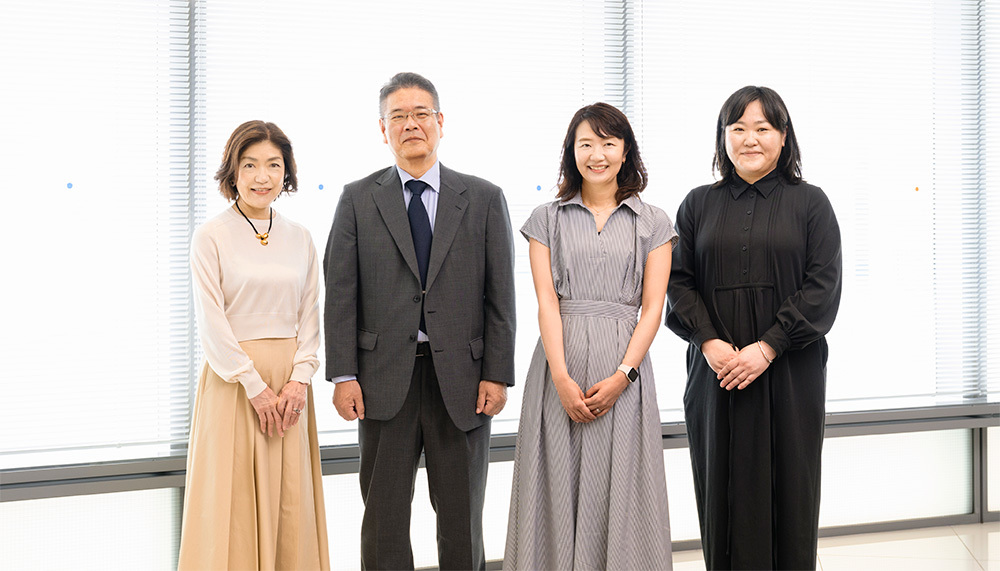
We spoke with Miwa Koshiishi, Assistant Director of the Information Utilization Support Office, Information Flow Promotion Division, Information and Communications Bureau, Ministry of Internal Affairs and Communications (center right in photo); Asako Kamimura, Director of the Public Relations Team, Nippon Foundation Telephone Relay Service (right in photo); and Ken Nishikawa, Director of the Text Display Telephone Team, Nippon Foundation Telephone Relay Service (center left in photo). The interviewer was Akiko Nomura of Dentsu Inc. (left in photo).
Dentsu Inc., in collaboration with eight domestic Dentsu Group companies, has produced the "Communication Design Guide for Everyone," aiming to realize communication that "leaves no one behind." It has been publicly available since January 28, 2025.
In this series, members of the Minna no Communication Design Guide Secretariat will introduce examples contributing to diversity and inclusion in communication while delving into their social significance.
This installment focuses on Yometeru, a phone service that displays the caller's voice as text, initially developed for people who sometimes struggle to hear the other party during calls. Why did they develop an app that transcribes the caller's voice? Unraveling the background and social context revealed the existence of approximately 14.3 million people (※1) who find phone communication difficult due to hearing impairments or other reasons.
What is necessary to build a society where everyone can naturally enjoy communication, recognizing the diversity of "everyone"?
※1 According to the Ministry of Health, Labour and Welfare, there are approximately 14.3 million people with hearing loss nationwide (about 10% of the population).
Telephone relay services are an essential public infrastructure for citizens' lives
Nomura: Starting January 23, 2025, we began offering "Yometeru," a phone that lets you read the other person's voice. First, could you briefly introduce the Yometeru service?
Uemura: Yometeru is a phone app that converts the caller's voice into text. It's designed for people who sometimes have difficulty hearing the other party's voice on the phone, such as those with hearing loss or who have become deaf later in life. A key feature is that it can be used bidirectionally, 24 hours a day, 365 days a year. By converting the caller's voice into text, it facilitates smoother communication over the phone and is one of the legally mandated public infrastructures.

Yometel is a phone app that allows users to convey their own voice to the person they are calling and read the other person's voice in text. It is a service for people who sometimes have difficulty hearing the other person's voice on the phone.
Nomura: You mentioned the service is provided based on law. Could you explain the social context that led to the creation of Yometeru?
Koshiishi: First, let me explain telephone relay services. Fundamentally, the telephone is a basic communication tool enabling real-time interaction with distant parties, playing a crucial role especially during emergencies or disasters. However, due to its reliance on voice communication, it poses significant challenges for individuals with hearing or speech impairments. The inability to make calls independently during emergencies was a life-threatening issue.
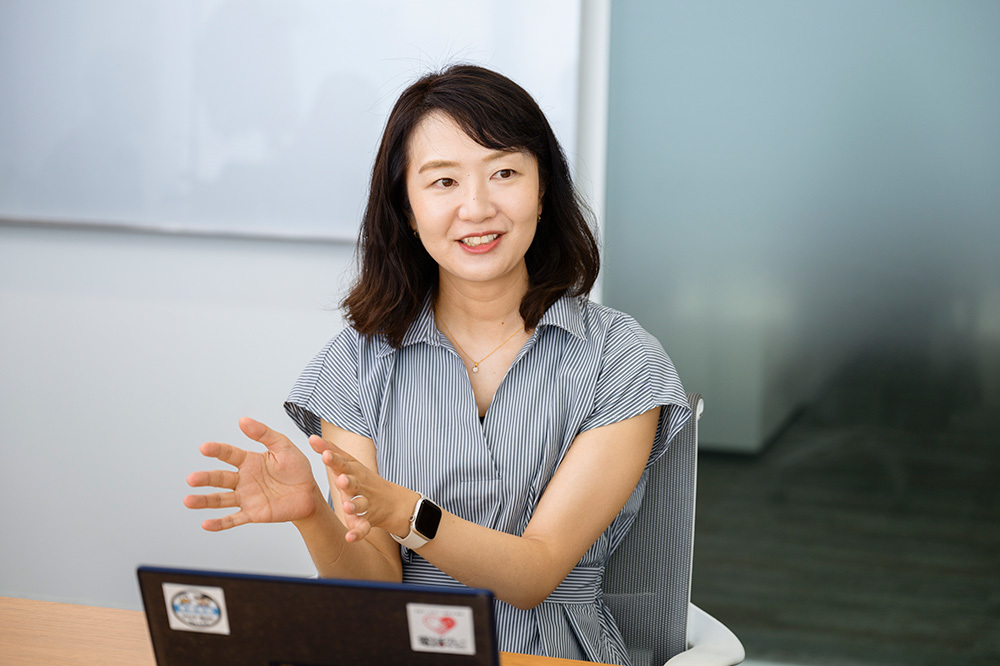
To address these various challenges, telephone relay services, already in operation overseas, were introduced. This service enables individuals who find telephone use difficult to communicate via telephone using sign language or text, facilitated by an interpreter operator.
In Japan, The Nippon Foundation began providing this service as a model project starting in September 2013. It enabled two-way communication between individuals with hearing or speech difficulties and hearing individuals by having relay operators interpret conversations using sign language, text, and voice.
Subsequently, as the Nippon Foundation's model project service was set to conclude in fiscal year 2020, discussions were held in groups such as the Telephone Relay Service Working Group of the Council for Realizing a Digital Inclusion Society. The Ministry of Internal Affairs and Communications then examined institutional arrangements. Consequently, the "Act on Facilitating Telephone Use by Persons with Hearing Disabilities, etc." was passed and enacted in June 2020. The telephone relay service was institutionalized (※2), and service provision as public infrastructure began in fiscal year 2021.
Nomura: I see. So the background was that the telephone relay service was institutionalized to make it accessible to anyone at any time and established as public infrastructure.
※2 Based on the law, the Japan Foundation Telephone Relay Service (a public interest incorporated foundation) was designated by the Minister of Internal Affairs and Communications as the sole nationwide provider of telephone relay services. It provides the service and conducts awareness activities.
Challenges and needs vary from person to person. It starts with understanding the diverse "everyone."
Nomura: So what challenges led to the development and launch of the Yometeru app and service?
Nishikawa: The telephone relay service we launched earlier provides interpretation between people with hearing or speech difficulties and hearing individuals. Interpreters use sign language, text, and voice to facilitate communication. According to a Ministry of Health, Labour and Welfare survey, there are currently approximately 379,000 people with hearing or speech disabilities (holders of disability certificates) in Japan. Among them, it is estimated that just under 80,000 people use sign language. This telephone relay service is available to those who use sign language.
However, the self-reported rate of hearing loss is said to be about 10% of Japan's population (※4).
※3 Ministry of Health, Labour and Welfare "2022 Survey on Difficulties in Daily Life"
※4 Japan Hearing Aid Manufacturers Association survey "JapanTrack 2022"

Uemura: For people who became deaf later in life, they relied on voice-based communication before losing their hearing. Many of them want to use their own voice. However, they couldn't hear the other person's voice, or could only hear it with difficulty, making phone use challenging.
Telephone relay services, which use sign language or text to make calls, don't allow them to convey things using their own voice. Consequently, there has long been a demand for a service that complements the other person's voice while allowing them to use their own.
Nomura: Were such services already available overseas?
Uemura: Similar needs exist overseas. In the US, for example, there's a service called Captioned Telephone Service (CTS). Consequently, there was significant demand in Japan for a service like CTS, which led to the development of Yometeru.
Koshiishi: While telephone relay services were previously limited to a small number of users, Yometeru's arrival has expanded the options available.
Nomura: At Mincomu Guide, we also communicate that people with disabilities have diverse needs. Yometer is one service addressing these varied needs, isn't it?
Additionally, Mincomu Guide features data stating that "the self-reported rate of hearing loss in Japan is approximately 10% of the population." This shows that far more people than we might realize struggle with hearing difficulties or hearing loss.
Uemura: Exactly. It's crucial for people to understand that hearing impairment isn't a single category; each person has different concerns and needs.
For those concerned about declining hearing! Using Yometel can help improve your quality of life
Nomura: Were there any particular considerations during the development and operation of the Yometeru app?
Uemura: As Mr. Koshiishi mentioned earlier, the phone is a fundamental tool for communicating with people at a distance. We made sure to reflect that philosophy in the Yometeru app. We focused on developing a simple user experience to avoid creating a gap in usability compared to the phone functions built into iPhone and Android operating systems.

※Image
Nishikawa: We conducted a trial run last summer and pursued usability by gathering feedback from many people. Specifically, aspects like the speed at which the other person's voice is converted to text, readability, and other features like making and receiving calls were developed through discussions that incorporated feedback from the users themselves.
Additionally, users can choose between AI (automatic speech recognition) and a text input operator for converting the other person's voice to text. This allows them to switch between the two: using AI (automatic speech recognition) when prioritizing speed and a more realistic call experience, or using the text input operator when seeking higher accuracy.
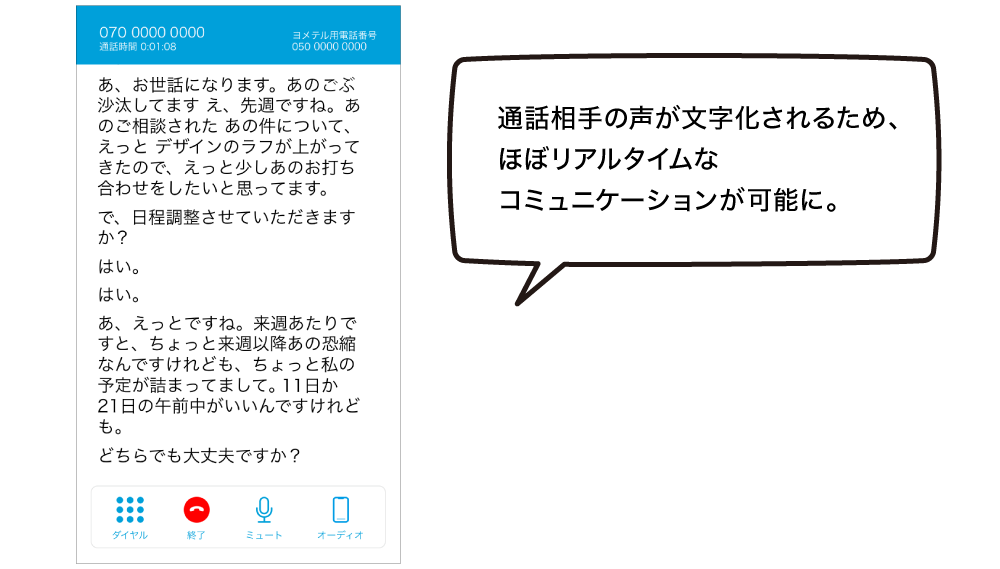
Actual call screen. The caller's voice is displayed as text like this.
Uemura: Some people don't feel particularly inconvenienced in their daily lives, but they might struggle to hear the mechanical sounds of a phone. For those individuals, Yometeru allows them to check the text only in those hard-to-hear situations.
Nomura: We also hope it will be used by people with age-related hearing loss that worsens with age, sudden sensorineural hearing loss, or those concerned about hearing loss from Meniere's disease, which is said to be more common in women. The service has only recently launched, but how is the adoption rate looking?
Nishikawa: Looking at our registrants, we currently see people who have been eagerly awaiting this service signing up and using it. However, as the data mentioned earlier indicates, considering that approximately 10% of Japan's population has hearing loss, one in ten people could potentially be a Yometeru user. Thinking about it this way, we recognize there are still many potential users, and the challenge is that information about Yometeru hasn't reached them yet.
We plan to continue our outreach and awareness efforts in this area, including reviewing registration methods and conducting information sessions and training workshops.
Toward a society where information reaches everyone equally. What does the Ministry of Internal Affairs and Communications do to ensure information accessibility?
Nomura: The Ministry of Internal Affairs and Communications oversees administrative functions vital to citizens' lives, such as local governance and social infrastructure, and I believe it also handles information and communications development. With the internet transforming society, what do you see as key priorities or challenges requiring focus?
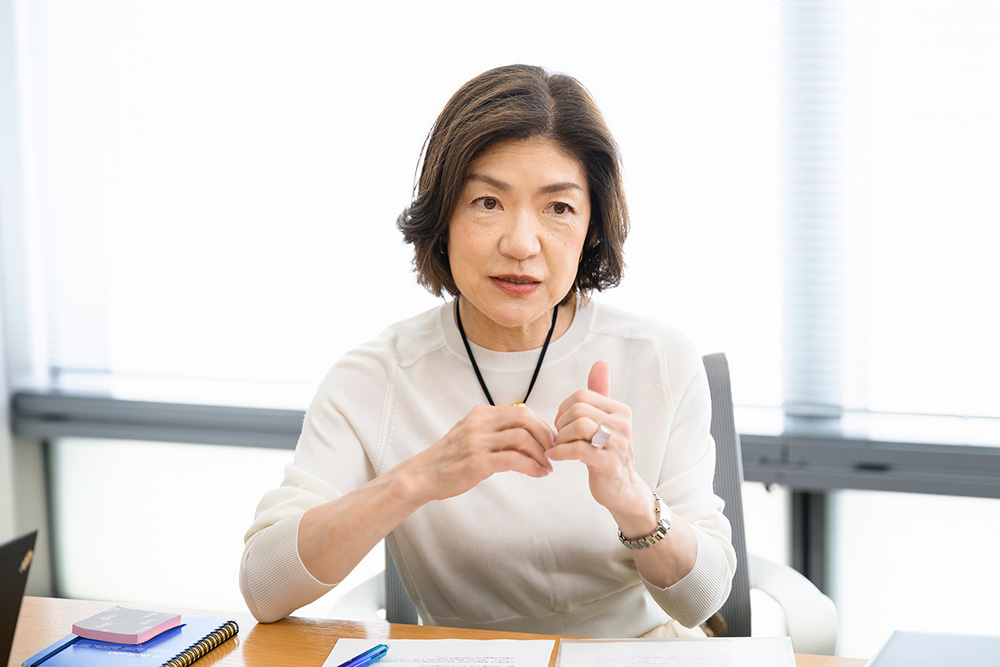
Koshiishi: Today, anyone can connect to the internet via smartphones, PCs, tablets, and various other devices, gaining access to vast amounts of information. Ensuring information accessibility is therefore critically important. Information accessibility means that everyone, regardless of age or disability, can easily find and utilize the information they need.
To give some clear examples: Is an easy-to-read font like UD Font being used? Are sentences overly long and difficult to understand? Are difficult kanji characters annotated with furigana? Are colors chosen with consideration for people with color blindness or the elderly? There are many points to be mindful of. However, I feel that many issues can be resolved with just a little consideration from those conveying the information.
Nomura: The "Mincom Guide" also assumes a diverse audience with varying needs—such as gender, age, and disability—and introduces necessary considerations and reference examples.
■Printing
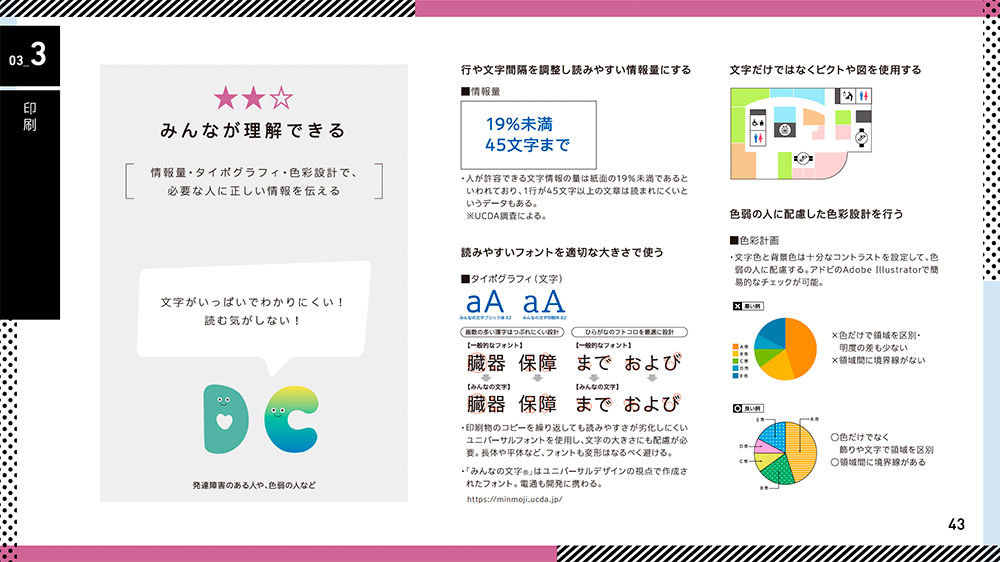
Adjusting line and character spacing to manageable amounts of information, or using easy-to-read fonts, makes it easier to convey the right information to those who need it.
■Video Content & Commercials
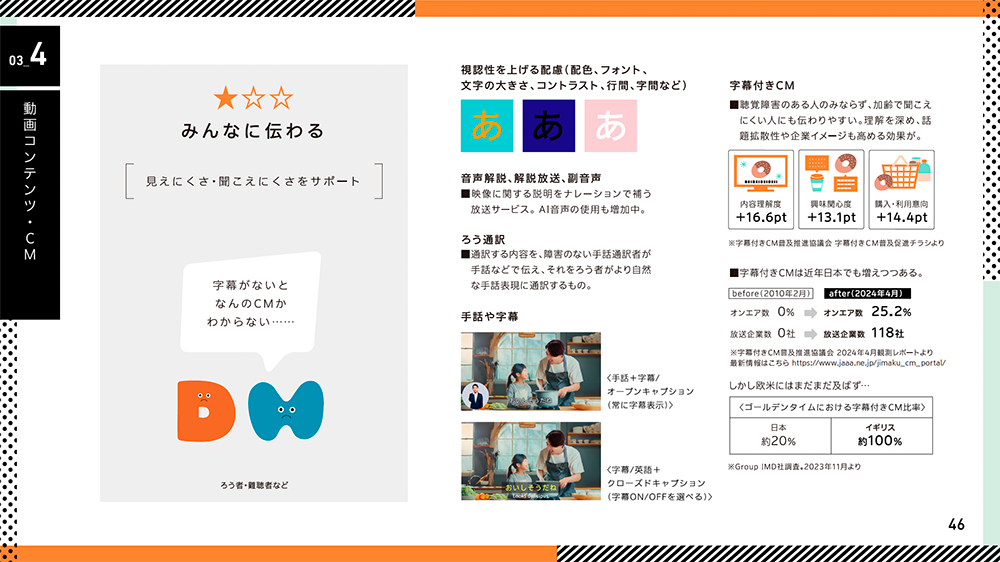
For video content and commercials, it's also important to implement measures that support those with visual or hearing impairments. This includes enhancing visibility through adjustments like color schemes and fonts, or adding captions.
Koshiishi: Having guides like this makes things much clearer, doesn't it?
The Ministry of Internal Affairs and Communications has also published the " Public Website Operation Guidelines" regarding website accessibility. Homepages of public institutions, including national and local governments, disseminate significant information for citizens. Therefore, to ensure they are accessible to everyone, including the elderly and people with disabilities, these guidelines outline standards and procedures for web accessibility and call for its improvement.
Nomura: In today's world where we can access diverse information online, improving web accessibility is a critical issue that not only public institutions but also many companies should be mindful of.
Koshiishi: That's right. We must also consider that information users include people with various characteristics, such as those with visual impairments, dyslexia (a learning disability involving difficulties with reading and writing), and foreign nationals.
I hope you will first imagine the diverse range of people among those you wish to reach with information, and then use the "Everyone's Public Website Operation Guidelines" as a reference to adjust elements like text size, video transition methods, and audio timing.
I believe that as more companies and organizations practice improving web accessibility, everyone will be able to access information without difficulty, eventually leading to communication where no one is left behind.
Nomura: While society has become more convenient, various internet-related issues have emerged, such as fake/misinformation, illegal part-time jobs, and online casinos. Could you tell us about any countermeasures being taken by the Ministry of Internal Affairs and Communications?
Koishi: Starting in January 2025, the Information Utilization Support Office at the Ministry of Internal Affairs and Communications launched an initiative called " DIGITAL POSITIVE ACTION." It is essential for every citizen to enhance their information literacy to avoid being deceived by fake information or inadvertently spreading it.
Precisely because we live in an era where anyone can easily access the internet, deepening our individual understanding of information accessibility and information literacy, and putting it into practice, is the first step toward building an inclusive society.
Nomura: Hearing your insights today has reaffirmed the critical importance of imagining the characteristics and needs of those we communicate with. I hope to start putting into practice what I can, such as considering information accessibility and improving information literacy. Thank you for your valuable insights today.
◎What is Communication Design for Everyone?
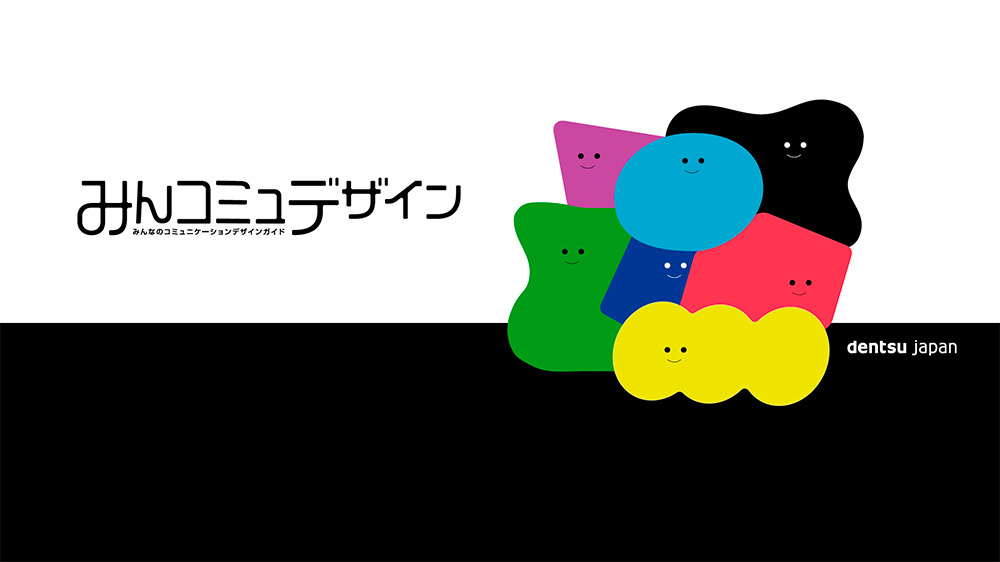
This approach aims to realize ideal communication for everyone, ensuring "no one is left behind." It is based on the premise that communication recipients have diverse characteristics and needs, including age, disability status, gender, nationality, and more. The "Communication Design for Everyone Guide" introduces the diverse "everyone" we aim to reach, covers the wide range of communication media that exist between senders and receivers, and provides necessary considerations and reference examples.























